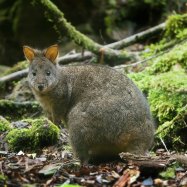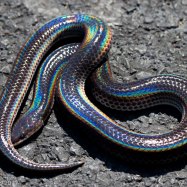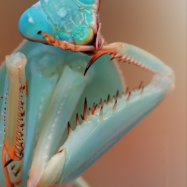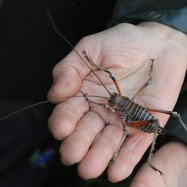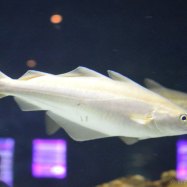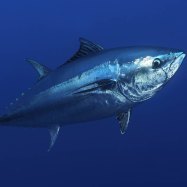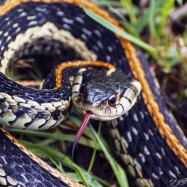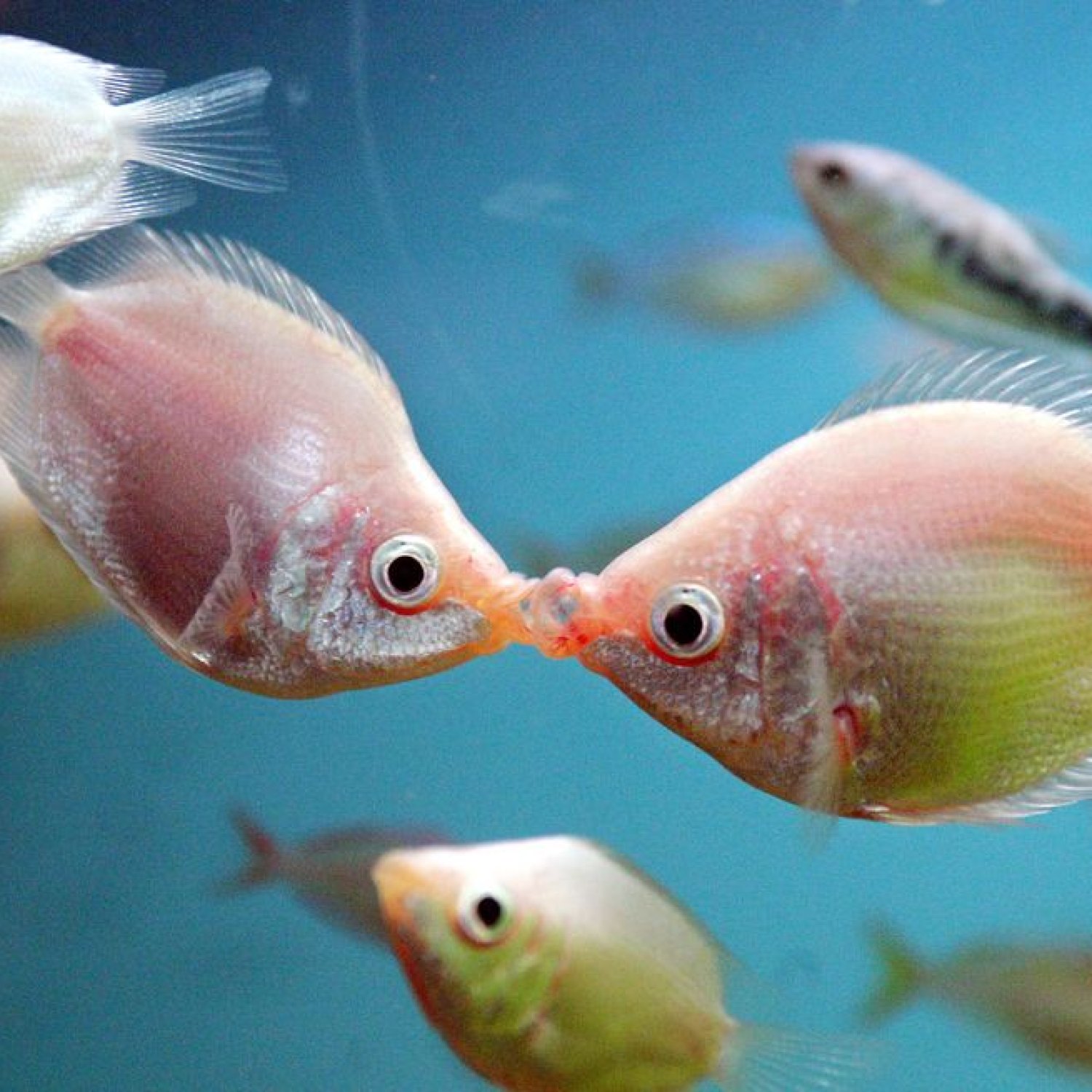
Kissing Gourami
Up to 30 cm (11.8 inches)
The Kissing Gourami is a popular freshwater fish known for its bright colors and peaceful nature. With a length of up to 30 cm, it is perfect for larger aquariums. Found in rivers, streams, and lakes, this fish, also known as a Kissing Fish, belongs to the Helostomatidae family and has an oval and laterally compressed body shape. A must-have for any fish lover's tank! #KissingGourami #FishFacts #AquariumLife
Animal Details Summary:
Common Name: Kissing Gourami
Kingdom: Animalia
Habitat: Freshwater
The Kissing Gourami: The Affectionate Aquatic Creature of Southeast Asia
Imagine strolling along the serene rivers, streams, and lakes of Southeast Asia, surrounded by lush greenery and the sounds of cascading waterfalls. As you take in the tranquil scenery, you suddenly catch a glimpse of a peculiar fish swimming gracefully in the clear waters. You notice its silver body with a pinkish hue, and its oval shape resembling a heart, and you can't help but wonder, "What kind of fish is this?" Well, my friend, you have just encountered the famous Kissing Gourami, the affectionate aquatic creature of Southeast Asia.The Kissing Gourami, also known as Helostoma temminckii, is a tropical freshwater fish that belongs to the Kingdom Animalia, Phylum Chordata, and Class Actinopterygii Kissing Gourami. It is classified under the order Perciformes and the family Helostomatidae, along with its close relative, the Thick-Lipped Gourami. This charming fish is native to Indonesia, Malaysia, Thailand, Vietnam, and Cambodia, and can be found in various bodies of water such as rivers, streams, and lakes.
Now, let's dive deeper into the world of the Kissing Gourami and discover the unique characteristics that make it one of the most beloved fish in the aquarium hobby.
A Symbol of Affection and Love
One of the distinctive features of the Kissing Gourami is its behavior of "kissing" its tankmates, which gave it its common name. This gentle behavior is not a sign of aggression, but rather an expression of affection and courtship between two gouramis. They usually form monogamous pairs and can be seen "kissing" each other by locking their lips together and performing a dance-like movement. This endearing gesture has captured the hearts of many aquarium enthusiasts, making the Kissing Gourami a popular choice for community tanks.Appearance and Body Shape
The Kissing Gourami has a unique body shape that sets it apart from other gouramis. It has an oval and laterally compressed body, resembling a heart, with a pointed head and a broad mouth Kerry Blue Terrier. Its fins are long and flowing, giving it a graceful and elegant appearance. The fish's body is covered in silver scales with a pinkish hue, making it a stunning addition to any aquarium.Size and Feeding Habits
The Kissing Gourami can grow up to 30 cm (11.8 inches) in length, making it one of the largest gourami species. However, in captivity, they usually average around 15 cm (5.9 inches). This fish is an omnivore and can eat a variety of foods such as insects, plants, and small crustaceans. In the wild, they love grazing on algae, but in captivity, they should be fed a well-balanced diet of high-quality flakes, pellets, and frozen foods.A Need for Clean Water
The Kissing Gourami, like other freshwater fish, requires clean and well-oxygenated water to thrive. They are sensitive to poor water conditions, and water quality should be closely monitored in their tank. A good filtration system, along with regular water changes, is vital to maintaining a healthy environment for these fish. They also prefer slightly acidic to neutral water with a pH level between 6.5 to 7.5.A Natural Marvel of Southeast Asia
The Kissing Gourami is not only an eye-catching addition to any aquarium, but it is also a natural wonder of Southeast Asia. It is endemic to the region and can be found in various habitats such as rivers, streams, and lakes. These fish are highly adaptable and can survive in different water conditions, making them a vital part of the ecosystem.However, due to habitat destruction and overfishing, the Kissing Gourami population has decreased in the wild. This has led to the species being listed as "near threatened" on the International Union for Conservation of Nature (IUCN) Red List. In recent years, there have been efforts to conserve and protect these fish through sustainable fishing practices and the preservation of their natural habitats.
Bringing the Kissing Gourami into Your Home
The Kissing Gourami is a popular choice for aquarium hobbyists, and with proper care, they can live up to 10-15 years in captivity. They are peaceful and can coexist with other peaceful fish, but it is best to keep them with other gouramis or fish of similar size. It is not advisable to keep them with aggressive or fin-nipping species.When setting up a tank for Kissing Gouramis, it is essential to provide hiding spots such as plants and decorations in their environment. These fish are shy and can get stressed in an open and bare tank. A tank size of at least 50 gallons is recommended for a pair of Kissing Gouramis. When it comes to water parameters, they prefer a temperature range of 24-28°C (75-82°F) and a pH level of 6.5 to 7.5.
The Captivating World of the Kissing Gourami
In conclusion, the Kissing Gourami is not just a pretty fish. It is an intelligent and affectionate creature that has captured the hearts of many with its unique behaviors and stunning appearance. From the tranquil waters of Southeast Asia to the serenity of your home aquarium, the Kissing Gourami is a natural marvel that continues to fascinate and charm people worldwide.So, the next time you come across this delightful fish, remember to appreciate its beauty and respect its natural habitat. With proper care and conservation efforts, we can ensure that future generations will continue to marvel at the amazing world of the Kissing Gourami.

Kissing Gourami
Animal Details Kissing Gourami - Scientific Name: Helostoma temminckii
- Category: Animals K
- Scientific Name: Helostoma temminckii
- Common Name: Kissing Gourami
- Kingdom: Animalia
- Phylum: Chordata
- Class: Actinopterygii
- Order: Perciformes
- Family: Helostomatidae
- Habitat: Freshwater
- Feeding Method: Omnivorous
- Geographical Distribution: Southeast Asia
- Country of Origin: Indonesia, Malaysia, Thailand, Vietnam, and Cambodia
- Location: Rivers, streams, and lakes
- Animal Coloration: Silver with a pinkish hue
- Body Shape: Oval and laterally compressed
- Length: Up to 30 cm (11.8 inches)
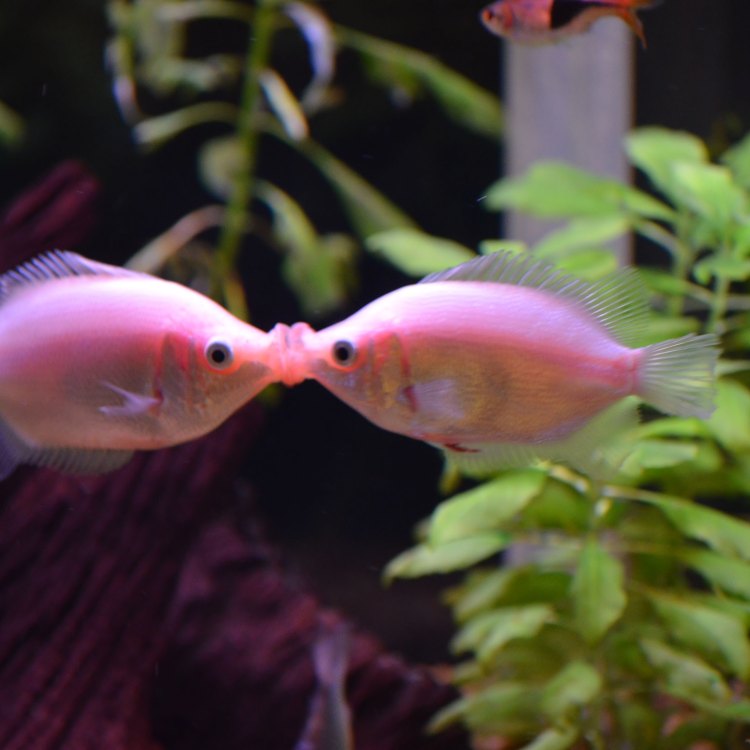
Kissing Gourami
- Adult Size: Around 20 cm (7.9 inches)
- Average Lifespan: 10-15 years
- Reproduction: Sexual
- Reproductive Behavior: Egg laying
- Sound or Call: No known sound or call
- Migration Pattern: Non-migratory
- Social Groups: Usually solitary
- Behavior: Peaceful and generally non-aggressive
- Threats: Habitat destruction, overfishing, and pollution
- Conservation Status: Not evaluated (NE)
- Impact on Ecosystem: Not significant
- Human Use: Popular aquarium fish
- Distinctive Features: Protrusible mouth and thick lips
- Interesting Facts: They get their name from their behavior of 'kissing' each other during courtship
- Predator: Large predatory fish
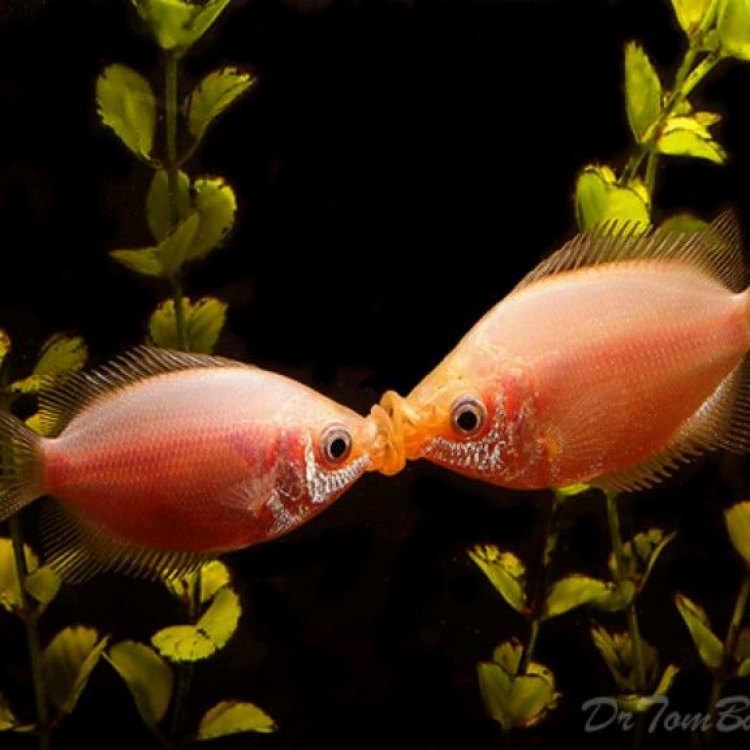
Helostoma temminckii
The Fascinating World of Kissing Gouramis: A Unique Fish Species
Have you ever heard of a fish that can kiss? Well, allow me to introduce you to the kissing gourami, a fascinating and unique fish species that captivates aquarists and fish enthusiasts all over the world. With its distinctive features, interesting behavior, and peaceful nature, it's no surprise that this fish has become a popular choice for aquariums. But beyond its popularity, there's much more to discover about this intriguing aquatic creature.So let's dive into the world of Kissing Gouramis and explore their impressive characteristics that make them stand out from other fish species PeaceOfAnimals.Com.
Origin and Habitat
The Kissing Gourami, scientifically known as Helostoma temminckii, is a tropical freshwater fish native to Southeast Asia, specifically Thailand, Malaysia, and Indonesia. It is commonly found in slow-moving rivers, streams, and ponds with dense vegetation and muddy bottoms. These fish thrive in warm and stable water conditions with a pH level of 6.0-8.0 and a temperature range of 75-83°F.Over the years, Kissing Gouramis have been introduced to other parts of the world, mainly for ornamental purposes. Due to their popularity, they have become an invasive species in some areas, causing harm to native fish populations.
Distinctive Features
One of the most distinctive features of the Kissing Gourami is its protrusible mouth, meaning it has the ability to extend its mouth outward to suck in food from hard-to-reach places. This unique adaptation helps them forage for food in tight spaces and compete for resources in their natural habitat King Mackerel.Another striking feature of these fish is their thick and rubbery lips, which help them scrape algae and other plant matter from surfaces. Apart from being functional, their lips also give them an endearing appearance, making them a popular choice for aquariums.
Size and Lifespan
On average, Kissing Gouramis can grow up to 20 cm (7.9 inches) in length, making them a medium-sized fish. In the wild, they can live up to 10-15 years, but in captivity, with proper care and environment, they can live even longer. It's important to note that these fish can grow quite large, so it's essential to have a spacious tank to accommodate their size and movement.Reproduction and Behavior
Kissing Gouramis are sexually dimorphic, meaning males and females have distinct physical characteristics. Males have brighter colors and pointed dorsal fins, while females have rounder and more subdued colors. These fish also have a unique reproductive behavior where females lay eggs on a surface, and males then fertilize them externally.One of the most fascinating behaviors of Kissing Gouramis is their "kissing" during courtship. As the name suggests, these fish get their name from the act of locking lips with each other. This behavior is also known as "fighting," as it is a way for males to establish dominance over a female during mating. But this behavior can also be seen as a display of affection and bond between partners.
Social Groups and Behavior
In their natural habitat, Kissing Gouramis are usually solitary and do not form large social groups. However, in aquariums, they can coexist peacefully with other fish species, especially community fish like tetras and catfish. They are generally non-aggressive and have a peaceful temperament, making them a great addition to a community tank.Kissing Gouramis are also known for their shy and skittish nature, which is why it's essential to have plenty of hiding places in the tank, such as plants and caves, to make them feel secure. When feeling threatened, these fish can release a toxic substance from their skin, so it's crucial to handle them with care.
Threats and Conservation Status
Like many other fish species, Kissing Gouramis face several threats in their natural habitat. Habitat destruction, overfishing, and pollution are the main factors contributing to their declining numbers. The demand for these fish in the ornamental trade has also put pressure on wild populations, leading to their introduction in new areas.Currently, the conservation status of Kissing Gouramis is not assessed, but their declining numbers suggest that they may be at risk. It's crucial to address these threats and implement conservation measures to protect these unique fish for future generations.
Human Use and Interesting Facts
Kissing Gouramis are a highly sought-after species in the aquarium trade due to their striking appearance and peaceful nature. In Southeast Asian countries, they are also used for food, and their scales are believed to have medicinal properties.Apart from their distinctive features and behavior, Kissing Gouramis are also known for their intelligence. They can recognize their owners and even learn to eat from their hands. These fish are also quick learners and can be trained to do simple tricks.
One interesting fact about Kissing Gouramis is that they are not known to make any sound or call. However, during spawning, males can produce grunting noises.
Predators and Ecosystem Impact
Being a medium-sized fish, Kissing Gouramis are preyed upon by larger predatory fish in their natural habitat, such as Arowanas and Snakeheads. Invasive species, like the African Snakehead, pose a significant threat to Kissing Gouramis in their native waters, as they compete for resources and can predate on them.However, the impact of Kissing Gouramis on their ecosystem is not significant. They primarily feed on plant matter, algae, and small invertebrates, and do not have a significant role in maintaining the balance in their environment.
The Perfect Fish for Your Aquarium
In conclusion, Kissing Gouramis are a unique and fascinating fish species that have captured the hearts of many aquarists and fish enthusiasts. With their distinctive features, interesting behavior, and peaceful temperament, they make a great addition to any community tank. However, it's crucial to provide them with a suitable environment and proper care to ensure their well-being. So if you're looking for a charming and unusual fish for your aquarium, the Kissing Gourami is undoubtedly the one for you.
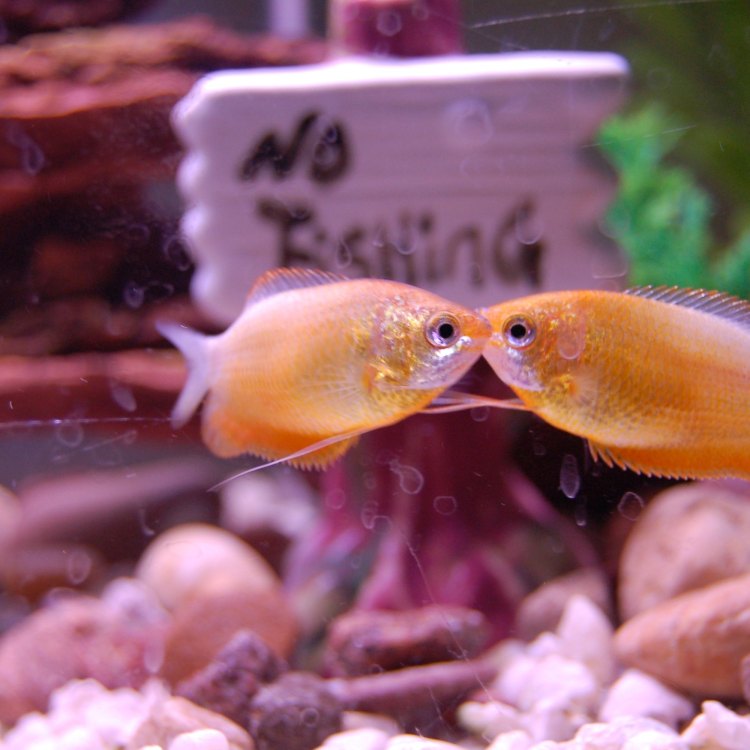
The Kissing Gourami: The Affectionate Aquatic Creature of Southeast Asia
Disclaimer: The content provided is for informational purposes only. We cannot guarantee the accuracy of the information on this page 100%. All information provided here may change without prior notice.



